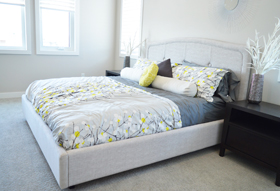Foam Mattress Toppers: A Buying Guide [2022]

Purchasing a new mattress is a big investment and is not one to be taken lightly. There are a range of factors to consider, such as your budget, size, chosen firmness, material composition and thickness. Despite new mattresses being competitively priced – particularly foam mattresses when bought direct from a manufacturer like Easyfoam – you may wish to investigate alternative solutions first. This is where a mattress topper often comes in useful.
Popular high street solutions include mattress toppers made from a synthetic microfibre filling. As these are widely available and an instant solution, people tend to gravitate towards this option. However, many do not realise that these toppers are best suited for the protection of your mattress, rather than for your added support. Synthetic toppers are typically selected to cover your mattress’s outer material.
For comfort and additional support – the primary reason many of us seek a mattress topper – foam solutions come highly recommended in place of a synthetic topper. Offering practical protection and unparalleled levels of support and comfort, foam mattress toppers can be ordered to specific sizing requirements and can work to give your mattress a new lease of life. Standard polyurethane mattress toppers come in a range of densities, typically between 1.5 inches to 4 inches, but can be made to specific requirements. If you are looking to rejuvenate an old mattress, or you weigh more than average, you may consider a thicker option. This also applies if you are typically a side-sleeper.
It is a combination of foam density and thickness that will help achieve your desired comfort level. For example, a polyurethane foam mattress topper of 1-inch thickness will usually provide only a little extra comfort, but if a high-density foam is selected, it can be equally as firm and supportive. Typically, this would be suitable for someone with a firm mattress seeking a little extra support. On the other hand, 3 to 4 inches of a medium density polyurethane foam is a good option if you are uncertain on how thick you would like your topper. Toppers in this depth range provide a good level of softness but also assist with giving the body a little extra support where needed.

An alternative option is a memory foam topper, typically sold as the luxury benchmark product. Memory foam toppers come in a range of thicknesses and densities (again, to your specification) and provide exceptional support for those suffering with joint, muscular or back pain. These toppers also typically reduce the transfer of noise between you and your partner should they disturb your sleep. Although buying a memory foam topper can be expensive, buying direct from Easyfoam is cheaper than the high street without sacrificing quality. Alternatively, you may wish to build a custom ‘combination’ foam topper, comprised of a polyurethane foam base and a thinner memory foam top layer.
When choosing your topper, it’s important to consider your sleeping position. If you sleep on your front and prefer a firmer feel, we recommend a high-density topper between 2 – 2.5 inches in thickness. Alternatively, for side and back sleepers, we recommend a medium to low density foam between 3 to 4 inches thick. Should you prefer a firmer surface as a side or back sleeper, selecting a higher density foam is an option.
Should you require any assistance with your foam mattress topper, including how to order ‘cut to size’, please contact Easyfoam today.
If you enjoyed this blog article, please feel free to share it on your favourite social media sites.

